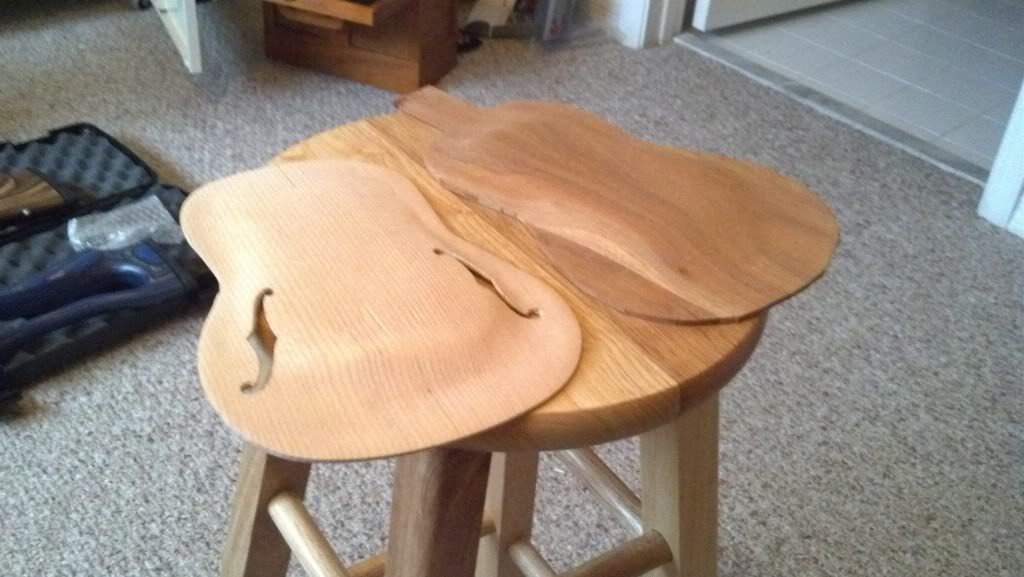Archtop Ukulele
Re: Archtop Ukulele
So using Cycloid Applet I generate 4 curves:
One Longitudinal
One the upper, waist and lower bound
My only concern is that I don’t know if the longitudinal Curve should be symmetrical for this time of build...
Cheers
One Longitudinal
One the upper, waist and lower bound
My only concern is that I don’t know if the longitudinal Curve should be symmetrical for this time of build...
Cheers
- Attachments
-
- lowerbound.pdf
- (4.73 KiB) Downloaded 657 times
-
- waist.pdf
- (3.92 KiB) Downloaded 615 times
-
- uper bound.pdf
- (3.75 KiB) Downloaded 584 times
-
- long Curve.pdf
- (6 KiB) Downloaded 591 times
Ruben Garcia, Miami Florida US
Re: Archtop Ukulele
Hello All,
As my name has been mentioned in this thread, I thought I would join in the fun. Many of you I know from other ukulele forums, Allen is certainly familiar, and I had the pleasure of meeting Graham at the 2008 GAL convention in Tacoma. I bought "The Mandolin Project" there which I highly recommend, by the way. I have been a part time luthier for close to thirty years now, current serial number is 205, hardly epic numbers, but it has been fun. My first few instruments were ukulele, which you could hardly give away then, so I quickly switched to mandolins and arch top guitars, which did sell well. So the bulk of my experience is in making carved top instruments. In 2009, when Kala introduced their F hole jazz ukulele, it tweaked my interest. My first thoughts at seeing the Kala were that is nice, but it is a pity they did not do it right. So I decided to give it a go and the first one, a tenor out of Engelmann spruce and big leaf maple had an exceptional sound. Very loud initially, but with less sustain than a flattop, exactly what I was after. I have built six more since then, a mixture of tenors and concert sizes, and all but one have sounded very good. The odd one out was a guitalele experiment, which was OK, but I will not do it again. About a year and a half ago, someone posted a thread on Ukulele Underground asking if it was possible to build a ukulele with just hand tools. I suggested that violins have been made that way for centuries and that it may be easier to build an arch top ukulele with hand tools than a flat top one. Thus I started the thread on "Building an Arch Top Ukulele" on UU. I've emailed out a lot of plans since then, many down under, and some very nice instruments have been built along those lines. As this is a new audience, if any of you wish to see these, just send me an email at donaldson_b@earthlink.net and I'll get them to you.
A quick review of Ruben's build show that most of you know your stuff, Graham, not surprisingly, has very good instincts. I graduate my tops and backs to 2mm in the recurve area and 3.6 mm or so in the center. The arch height is about 14 - 15 mm and the bridge height is 15 mm. So, if I can offer any more help, fire away, and I'll do my best to answer any other questions.
Brad
As my name has been mentioned in this thread, I thought I would join in the fun. Many of you I know from other ukulele forums, Allen is certainly familiar, and I had the pleasure of meeting Graham at the 2008 GAL convention in Tacoma. I bought "The Mandolin Project" there which I highly recommend, by the way. I have been a part time luthier for close to thirty years now, current serial number is 205, hardly epic numbers, but it has been fun. My first few instruments were ukulele, which you could hardly give away then, so I quickly switched to mandolins and arch top guitars, which did sell well. So the bulk of my experience is in making carved top instruments. In 2009, when Kala introduced their F hole jazz ukulele, it tweaked my interest. My first thoughts at seeing the Kala were that is nice, but it is a pity they did not do it right. So I decided to give it a go and the first one, a tenor out of Engelmann spruce and big leaf maple had an exceptional sound. Very loud initially, but with less sustain than a flattop, exactly what I was after. I have built six more since then, a mixture of tenors and concert sizes, and all but one have sounded very good. The odd one out was a guitalele experiment, which was OK, but I will not do it again. About a year and a half ago, someone posted a thread on Ukulele Underground asking if it was possible to build a ukulele with just hand tools. I suggested that violins have been made that way for centuries and that it may be easier to build an arch top ukulele with hand tools than a flat top one. Thus I started the thread on "Building an Arch Top Ukulele" on UU. I've emailed out a lot of plans since then, many down under, and some very nice instruments have been built along those lines. As this is a new audience, if any of you wish to see these, just send me an email at donaldson_b@earthlink.net and I'll get them to you.
A quick review of Ruben's build show that most of you know your stuff, Graham, not surprisingly, has very good instincts. I graduate my tops and backs to 2mm in the recurve area and 3.6 mm or so in the center. The arch height is about 14 - 15 mm and the bridge height is 15 mm. So, if I can offer any more help, fire away, and I'll do my best to answer any other questions.
Brad
Re: Archtop Ukulele
Well you already helped me a lotBradford wrote:Hello All,
As my name has been mentioned in this thread, I thought I would join in the fun. Many of you I know from other ukulele forums, Allen is certainly familiar, and I had the pleasure of meeting Graham at the 2008 GAL convention in Tacoma. I bought "The Mandolin Project" there which I highly recommend, by the way. I have been a part time luthier for close to thirty years now, current serial number is 205, hardly epic numbers, but it has been fun. My first few instruments were ukulele, which you could hardly give away then, so I quickly switched to mandolins and arch top guitars, which did sell well. So the bulk of my experience is in making carved top instruments. In 2009, when Kala introduced their F hole jazz ukulele, it tweaked my interest. My first thoughts at seeing the Kala were that is nice, but it is a pity they did not do it right. So I decided to give it a go and the first one, a tenor out of Engelmann spruce and big leaf maple had an exceptional sound. Very loud initially, but with less sustain than a flattop, exactly what I was after. I have built six more since then, a mixture of tenors and concert sizes, and all but one have sounded very good. The odd one out was a guitalele experiment, which was OK, but I will not do it again. About a year and a half ago, someone posted a thread on Ukulele Underground asking if it was possible to build a ukulele with just hand tools. I suggested that violins have been made that way for centuries and that it may be easier to build an arch top ukulele with hand tools than a flat top one. Thus I started the thread on "Building an Arch Top Ukulele" on UU. I've emailed out a lot of plans since then, many down under, and some very nice instruments have been built along those lines. As this is a new audience, if any of you wish to see these, just send me an email at donaldson_b@earthlink.net and I'll get them to you.
A quick review of Ruben's build show that most of you know your stuff, Graham, not surprisingly, has very good instincts. I graduate my tops and backs to 2mm in the recurve area and 3.6 mm or so in the center. The arch height is about 14 - 15 mm and the bridge height is 15 mm. So, if I can offer any more help, fire away, and I'll do my best to answer any other questions.
Brad
Ruben Garcia, Miami Florida US
- graham mcdonald
- Blackwood
- Posts: 473
- Joined: Thu Oct 25, 2007 11:57 am
- Location: Canberra
- Contact:
Re: Archtop Ukulele
Ruben,
Don't get too stressed by having your curves exactly following the curtate cycloid curves. Do them so the peak of the arch is under your bridge. A simple way to draft is on a piece of heavy card (I'm a non-CAD person) and here is a pic of the tools I use to do these. A flexible ruler is very useful
Hello Brad, good of you join us
cheers
graham
Don't get too stressed by having your curves exactly following the curtate cycloid curves. Do them so the peak of the arch is under your bridge. A simple way to draft is on a piece of heavy card (I'm a non-CAD person) and here is a pic of the tools I use to do these. A flexible ruler is very useful
Hello Brad, good of you join us
cheers
graham
Graham McDonald
http://www.mcdonaldstrings.com
http://www.mcdonaldstrings.com
Re: Archtop Ukulele
Thanks for the welcome Graham. I remember that there was some mention in the thread as to whether bracing the top was necessary or not. My first thoughts were to forego bracing entirely due to the low string tension. After considering that you want the top to vibrate up and down like an air pump, I decided to add some light parallel braces to assist this motion. It would be interesting to compare one without braces to one with them.
Brad
Brad
Re: Archtop Ukulele
Welcome on board Brad. Good to have you join us. It's a very friendly place and were all pretty easy going. Not like some other places out there that tend to take themselves a little too serious.
Re: Archtop Ukulele
Ur r right anyways I exhausted my intends of exporting those curves into my autocad… but more traditional approach will do, tomorrow I will reduce the top thickness and see what happenGraham McDonald wrote:Ruben,
Don't get too stressed by having your curves exactly following the curtate cycloid curves. Do them so the peak of the arch is under your bridge. A simple way to draft is on a piece of heavy card (I'm a non-CAD person) and here is a pic of the tools I use to do these. A flexible ruler is very useful
Hello Brad, good of you join us
cheers
graham
Ruben Garcia, Miami Florida US
Re: Archtop Ukulele
Hey I use the dimensions that u gave me I Input them into Gthang software, and I generated a nice Uku with an cutway , I will work a little more into it and if u want I will send it to u on a .PDF fileBradford wrote:Thanks for the welcome Graham. I remember that there was some mention in the thread as to whether bracing the top was necessary or not. My first thoughts were to forego bracing entirely due to the low string tension. After considering that you want the top to vibrate up and down like an air pump, I decided to add some light parallel braces to assist this motion. It would be interesting to compare one without braces to one with them.
Brad
Ruben Garcia, Miami Florida US
Re: Archtop Ukulele
Thanks very much Allen, friendly and fun are what I am all about. I did spend some time yesterday poking about the forum and have to say I am very impressed with the quality and amount of good information available here.
Brad
Brad
Re: Archtop Ukulele
Some good progress this Saturday
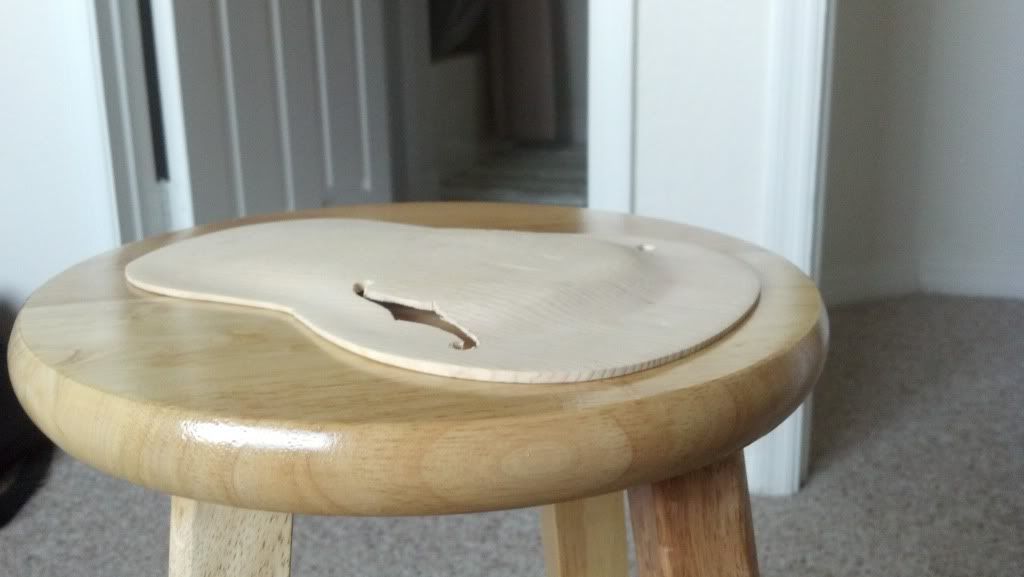
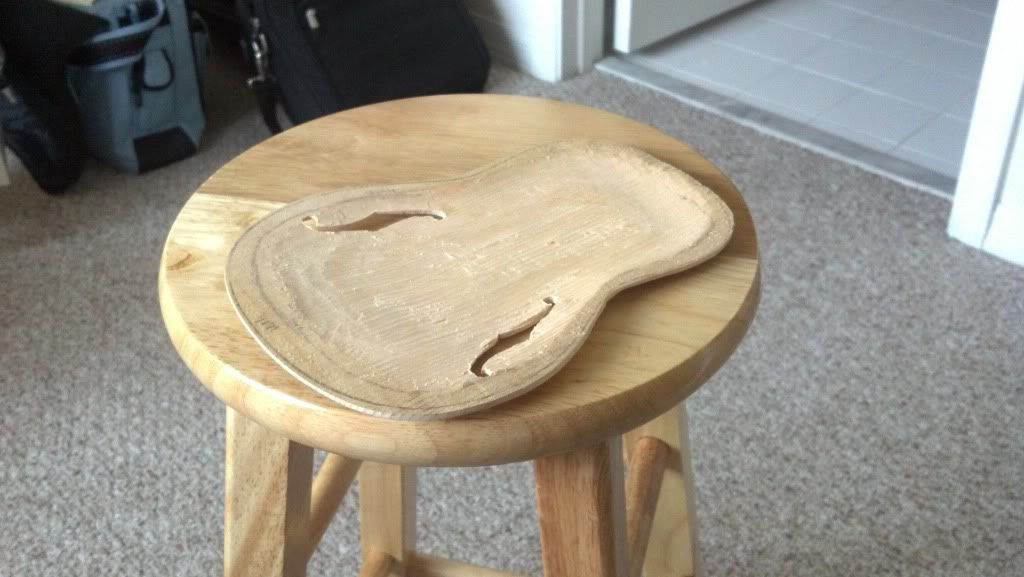
But I ran into a little trouble...I carved too close to the Edge of the top (can u see the pencil marks).... it wouldnt be a trouble but I wanted to bind the UKU
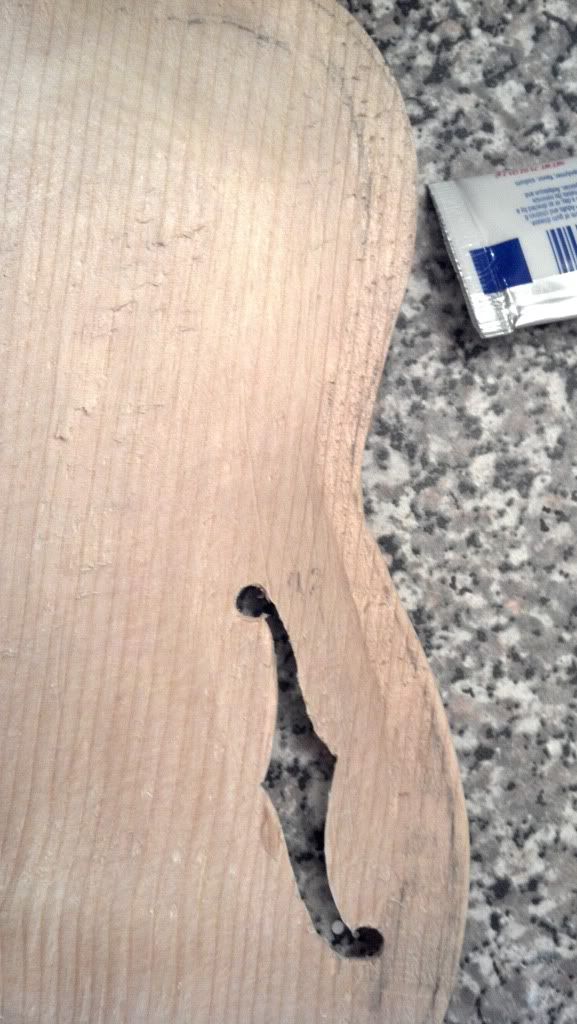
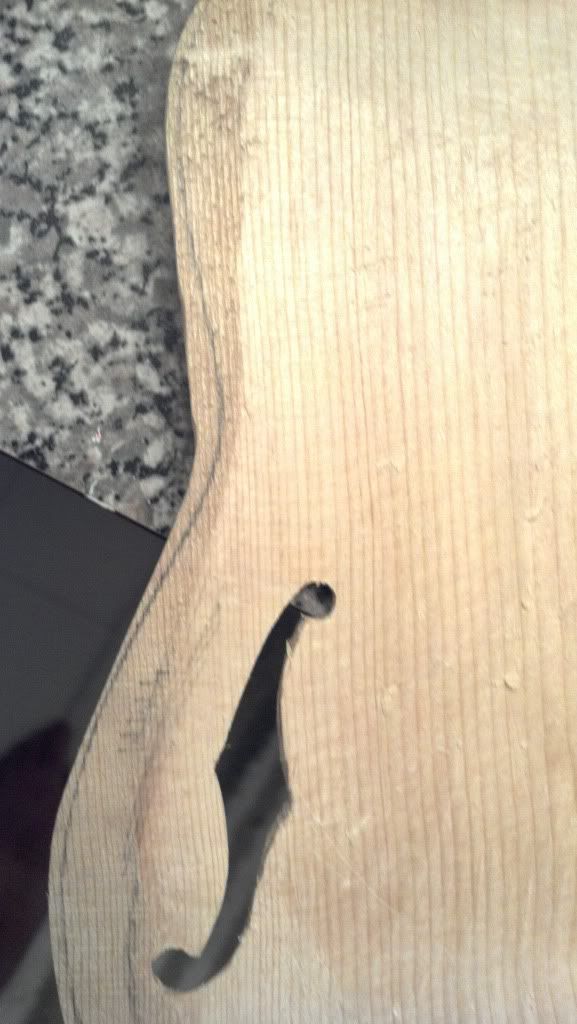


But I ran into a little trouble...I carved too close to the Edge of the top (can u see the pencil marks).... it wouldnt be a trouble but I wanted to bind the UKU


Ruben Garcia, Miami Florida US
Re: Archtop Ukulele
You could try and build the area back up with several layers of thin veneer. I always carve the insides of the top and back first. After the wedges have been book matched, I sand the outside flat, down close to the final height. The flat area makes it easier to hold the top while carving the inside. And if you go too far, a couple of passes on the belt sander can make things right.
Brad
Brad
Re: Archtop Ukulele
I some time ago Re-edged a double bass, that's a lot of work jejeje may be more that Star all over (This is a good experience for me i know next time to plan for this)... but other than that the top is fine... I really cant figured out how to star carving from the inside fist, i see it does haves some advantages, but I will get confuse, how can i figured out the outside shape then???Bradford wrote:You could try and build the area back up with several layers of thin veneer. I always carve the insides of the top and back first. After the wedges have been book matched, I sand the outside flat, down close to the final height. The flat area makes it easier to hold the top while carving the inside. And if you go too far, a couple of passes on the belt sander can make things right.
Brad
Ruben Garcia, Miami Florida US
Some slow progress
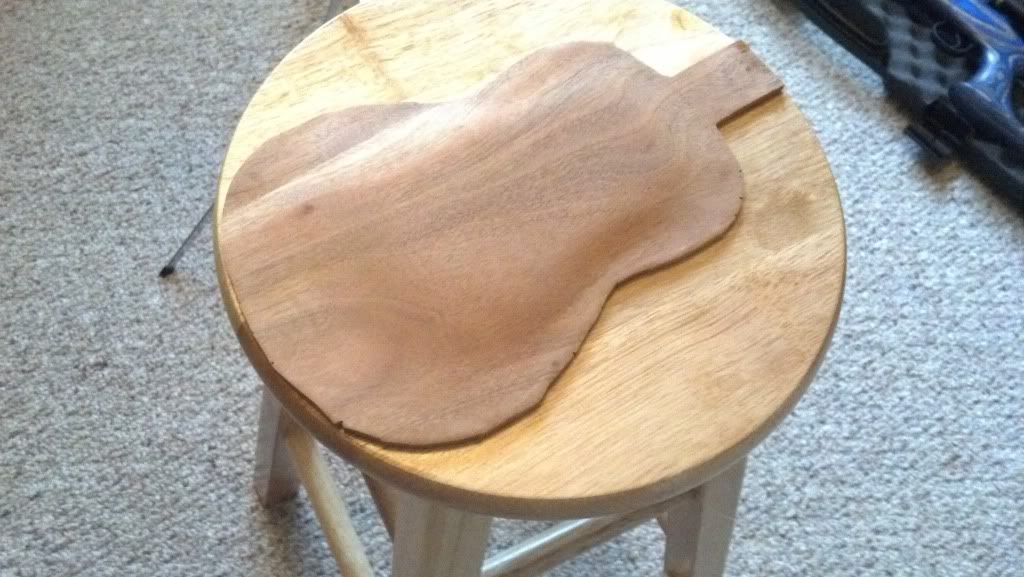 . The back.... I love mahogany , it's so easy to work with, too bad it's so expensive! Thanks to u guys no mistakes so far....
. The back.... I love mahogany , it's so easy to work with, too bad it's so expensive! Thanks to u guys no mistakes so far....Ruben Garcia, Miami Florida US
Who is online
Users browsing this forum: No registered users and 70 guests
